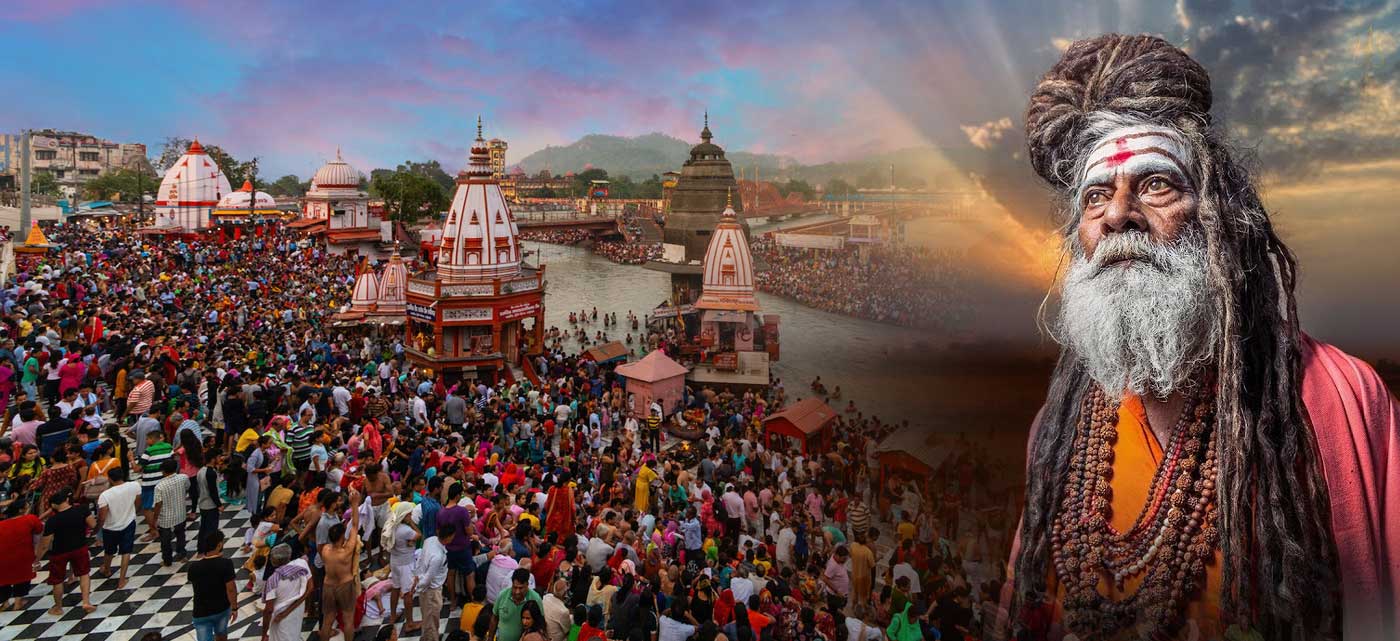Shahi Snan Dates for Maha Kumbh
Maha Kumbh will long for a month in which there will be many auspicious days.
Here is a schedule for Bathing Dates for Maha Kumbh or Maha Kumbh Shahi Snan in Haridwar. Millions of pilgrims and devotees take bath on Dates of Shahi Snan in Maha Kumbh for which prior preparations are made.
-
Makar Sankranti
 14 January
14 January -
Mauni Amavasya
 11 February
11 February -
Basant Panchami
 16 February
16 February -
Magh Poornima
 27 February
27 February -
Maha Shivratri (Shahi Snan)
 11 March
11 March -
Somvati Amamvasya (Shahi Snan)
 12 April
12 April -
Chaitra Shukla Prati Prada
 13 April
13 April -
Baisakhi (Shahi Snan)
 14 April
14 April -
Ram Navami
 21 April
21 April -
Chaitra Purnima (Shahi Snan)
 27 April
27 April
14 January : Makar Sankranti (Shahi Snan)
According to ancient Indian tradition, Kumbh Mela marks its beginning on Makar Sankranti, the day when the sun and moon enter Capricorn and Jupiter enters Aries which is considered to be particularly auspicious because as per ancient belief, the path from our Earth to other higher planets is open on this day, enabling the soul to attain the heavenly world. On this day at dawn, an immense crowd of millions of pilgrims walk towards holy Ganges and there are people chanting and flags and banners flowing all over.
16 February : Basant Panchami
The Amavasya of Magh Masa is called the Mauni Amavasya. Sun and Moon enter and the Capricorn sign, because of the transit, on this day. The day is celebrated as the birthday of Manu Rishi. It is believed, Lord Brahma gave origination to Maharaja Manu and queen Shatrupa. Hence, this day is considered as the beginning of the universe creation. Capricorn sign has the Yoga of Sun and Moon which increases the significance of this Amavasya. Bathing in gives virtues to an individual, on this day. According to some scholar, Maun Vrat should be observed. Maun (silent) Vrat (vow) means to control all our senses. It depends on a person for how long he wants to observe silence. People take the resolution of Maun Vrat for a day, or a month, or for one year.
27 February : Maghi Purnima (Sant Ravidas Jayanti)
Magh Purnima or Magha Pournami, also known as Maha Maghi, is one of the auspicious Pournami days for Hindu devotees. Purnima is considered as significant in terms of spiritual practice and performing religious rituals. Samudra Snan or Punya Nadi Snanam (holy dip in holy waters) on Maha Maghi is highly meritorious deed. It is auspicious for Snana, Daana, Japa, and Parayana.
11 March : Maha Shivratri (Shahi Snan)
Maha Shivratri, a Hindu festival celebrated annually in honour of the god Shiva. There is a Shivaratri in every luni-solar month of the Hindu calendar, on the month’s 21st night/ 22nd day, but once a year in late winter (February/March). It is observed by remembering Shiva and chanting prayers, fasting, doing Yoga, and meditating on ethics and virtues such as self-restraint, honesty, noninjury to others, forgiveness, and the discovery of Shiva.
28 march : Phalguna Purnima
Phalguna Purnima refers to the ‘full moon day’ on the eleventh month of the Hindu lunar calendar, Phalguna. It is believed that fasting from sunrise to moonlight on this day is extremely auspicious and those who observe a fast receive Lord Vishnu’s blessings and an end to all their sufferings. Devotees also take a dip in the Ganges river to wash away all their sins.
12 April : Somvati Amavasya (Shahi Snan)
Somvati Amavasya is a Sanskrit word which literally translates to ” New moon day occurring on a Monday”. Amavasya or ‘new moon day’ is considered auspicious in Hindu culture. Also, on this day, married Hindu women observe a fast to pray for the long lives of their husband while unmarried Hindu ladies fast to pray for a suitable match for themselves. On this day, prayers are offered to Lord Shiva and to one’s deceased ancestors by taking a dip in the holy Ganges river and no better place than Haridwar during Kumbh Mela on this special day.
14 April : Mesha Sankranti (Shahi Snan)
On Mesha Sankranti, Prayers are offered to the Sun God in celebration of the Solar New Year. Devotees make pilgrimage to holy places to mark this important Hindu festival. ‘Punya Kaal Mahurat’ is a time duration of ’40 Ghatis’ or 16 hours during which is considered auspicious for all activities such as taking bath in the holy river, offering ‘prasad’ and prayers to the Sun lord and offering charity to the needy. The important festival is celebrated with lot of fervour and festivity during Kumbh Mela.
21 April : Rama Navami
On the ninth day of the first month of the Hindu lunar calendar, ‘Ram Navami’ or Lord Ram’s Birthday is celebrated with great joy and fervour. On this day, chants of “Jai Shri Rama’ are heard throughout the day and celebrations reach a crescendo during mid-day which was the birth time of Lord Rama. tradition Having a dip in the holy river is considered very auspicious and to be in Haridwar during Kumbh Mela is every Hindu’s dream.
27 April : Chaitra Purnima (Shahi Snan)
The full moon day during the month of Chaitra according to the Hindu Lunar Calendar is celebrated as Chaitra Purnima. On this day, prayers are offered to Chitragupta, the keeper of Deeds, who observes our actions, labelling them as either positive Karma or negative Karma and then declares the result to Yama, the God of Death. A bath in the holy river on this day and begets them virtues for their next life especially during Kumbh Mela in Holy Ganges will remove all their sins.
 +91 9799050299
+91 9799050299 

